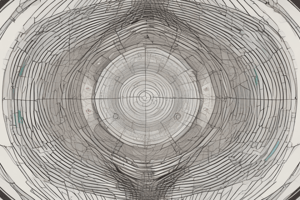Podcast
Questions and Answers
What are relations in mathematics?
What are relations in mathematics?
- A type of equation
- A set of ordered pairs (correct)
- A collection of functions
- The domain of a function
What are functions?
What are functions?
A rule that assigns to each number x in the function's domain a unique number f(x).
What is the domain in a function?
What is the domain in a function?
All possible input values (x values).
What is the range in a function?
What is the range in a function?
What is function notation?
What is function notation?
What are dependent variables?
What are dependent variables?
What is the slope-intercept form of a line?
What is the slope-intercept form of a line?
What is an equation?
What is an equation?
What is the associative property?
What is the associative property?
What does the term 'coefficient' refer to?
What does the term 'coefficient' refer to?
What is a function?
What is a function?
What defines a linear function?
What defines a linear function?
What is the purpose of a histogram?
What is the purpose of a histogram?
What is the median in a data set?
What is the median in a data set?
What is quadratic function?
What is quadratic function?
What is the interquartile range?
What is the interquartile range?
Flashcards are hidden until you start studying
Study Notes
Relations and Functions
- Relations: A set of ordered pairs defining how inputs relate to outputs.
- Functions: A specific type of relation where each input has a single output.
- Function Notation: A way to represent functions, typically written as f(x).
- Domain: The set of all possible input values (x values) for a function.
- Range: The set of all possible output values (y values) for a function.
Types of Functions
- Parent Functions: The simplest form of functions in a family (e.g., linear, quadratic).
- Dependent Variable: The output of a function, which relies on the input or independent variable.
- Linear Function: Preserves a constant rate of change; represented as y = mx + b, where m is slope and b is y-intercept.
- Quadratic Function: Characterized by the x² term; often in the form y = ax² + bx + c.
Mathematical Properties
- Slope-Intercept Form: y = mx + b; describes the relationship in linear equations.
- Commutative Property: States that changing the order of numbers does not affect the sum or product (e.g., a + b = b + a).
- Associative Property: Indicates that the way numbers are grouped does not change their sum or product (e.g., (a + b) + c = a + (b + c)).
- Distributive Property: Describes how to distribute multiplication over addition or subtraction (e.g., a(b + c) = ab + ac).
Data Management and Stats
- Bivariate Data: Involves two variables being measured simultaneously.
- Box and Whisker Plot: A graphical representation of data that shows the distribution based on five-number summary (min, Q1, median, Q3, max).
- Cumulative Frequency Table: Displays total occurrences of data points as they accumulate across intervals.
- Measures of Central Tendency: Common measures include mean (average), median (middle value), and mode (most frequent value).
Graphical Concepts
- Scatter Plot: A graph used to show relationships between two variables without connecting the dots.
- Line of Best Fit: A line that approximates the relationship between two variables, reducing scatter while maintaining the trend.
- Parabola: The U-shape graph produced by quadratic functions.
Algebraic Components
- Polynomial: A mathematical expression consisting of variables, coefficients, and positive whole number exponents (e.g., 2x² + 3x + 1).
- Monomial: A polynomial with a single term.
- Binomial: A polynomial with two terms (e.g., x + 4).
- Trinomial: A polynomial with three terms.
Sequences and Series
- Arithmetic Sequence: A sequence with a constant additive rate of change.
- Geometric Sequence: A sequence where each term is multiplied by a constant rate of change.
Equation Solutions
- Roots of an Equation: Solutions where the function equals zero, found by identifying x-intercepts on a graph or using factoring techniques.
- Solution Set: A collection of values that satisfy an equation or inequality.
Other Key Definitions
- Exponent: Indicates how many times to multiply the base by itself.
- Coefficient: The numerical factor before a variable in a term.
- Zeros of a Graph: Points on the x-axis where the value of the function is zero (intercepts).
- Residual: The difference between actual and predicted values, indicating the accuracy of a model.
Advanced Concepts
- Correlation: Indicates the strength of the relationship between two variables.
- Exponential Functions: Functions representing growth or decay where a constant base is raised to a variable exponent.
- Irrational Numbers: Numbers that cannot be expressed as fractions (e.g., √2, π).
- Rational Numbers: Numbers that can be expressed as fractions.
Transformations
- Vertical and Horizontal Shifts: Changes to the position of a graph based on function transformations.
- Dilation: Alteration of a graph's visual presentation, affecting its width or height.
Final Notes
- Causal Relationship: Links whether variations in one variable cause changes in another, distinguishing it from correlation.
Studying That Suits You
Use AI to generate personalized quizzes and flashcards to suit your learning preferences.




